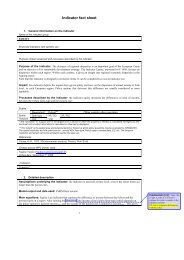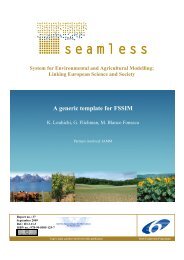Farming Systems Design 2007 - International Environmental ...
Farming Systems Design 2007 - International Environmental ...
Farming Systems Design 2007 - International Environmental ...
You also want an ePaper? Increase the reach of your titles
YUMPU automatically turns print PDFs into web optimized ePapers that Google loves.
<strong>Farming</strong> <strong>Systems</strong> <strong>Design</strong> <strong>2007</strong><br />
Field-farm scale design and improvement<br />
INTEGRATED ASSESSMENT OF AGRICULTURAL SYSTEMS:<br />
A CHALLENGE OF SYSTEM AND MODEL COMPLEXITY<br />
J.J Stoorvogel 1 , J. Antle 2<br />
1 Landscape Centre, Wageningen University, The Netherlands, jetse.stoorvogel@wur.nl<br />
2<br />
Dep. of Ag. Econ. and Econ., Montana State University, USA, jantle@montana.edu<br />
Introduction<br />
There is an increasing demand for the integrated assessment of complex agricultural systems.<br />
Integrated modeling approaches are a common tool to deal with this type of analysis. However,<br />
despite the fact that simulation models are simplifications of reality, we see that these models<br />
become increasingly complicated. Additional processes are included to make the models generic<br />
and to describe properly the observed variation in these agricultural systems. The complexity of<br />
these models coincides with an increase in data requirements. As a result of the almost unrealistic<br />
data requirements, many applications are unable to collect the input data. Several approaches are<br />
being used to deal with the data requirements. Many studies use default model values for data that<br />
were not available and/or difficult to measure. In other studies transfer functions are used to<br />
estimate e.g., complex hydrological properties on the basis of soil texture and organic matter<br />
contents. In the case of significant spatial variation, studies use a limited number of representative<br />
locations (e.g. representative weather stations, representative soil profiles, or farm types). The<br />
question that remains is whether we should search for simplifications or whether we should look for<br />
more simple models that are capable to run the key processes using mostly available data?<br />
In this study, we looked at the Tradeoff Analysis Model and its application to the potato-pasturewheat<br />
system in the Peruvian Andes (Antle et al., <strong>2007</strong>). Crop growth simulation models,<br />
econometric simulation models, and mechanistic erosion models are integrated through the<br />
Tradeoff Analysis Modeling system (Stoorvogel et al., 2004) to properly describe this complex<br />
system. The advantage of the integrated modeling approach is that we can evaluate a wide range<br />
of alternative scenarios ranging from climate change, terrace adoption, to economic policies. The<br />
key question that remains is whether we need such a complex modeling system if we are<br />
interested in a specific policy or research question. To illustrate this we will look at the specific<br />
issue on the adoption of terraces.<br />
Methodology<br />
The study focuses on the semi-arid La Encañada watershed in the Cajamarca region in northern<br />
Peru. The 10km 2 watershed ranges between 2,950 to 4,000 meters above sea level and is located<br />
between 7°00' and 7°07' southern latitude and betwe en 78°15' and 78°22' western longitude.<br />
Average annual rainfall is low ranging between 430 mm/year in the valleys up to 550 mm/year in<br />
the higher parts of the watershed. The data used in this analysis were collected through farm<br />
surveys conducted in 1997-1999 for a random stratified sample of 40 farm households in five<br />
communities in the watershed. The data show that crop yields are low and parcel size is small, as<br />
is typical of this type of semi-subsistence agriculture. The analysis reported here is based on the<br />
lower-hillside region where cropland is the principal land use. In the last decades a large number of<br />
fields were terraced to reduce soil erosion and maintain soil fertility. The Tradeoff Analysis Model<br />
simulates land allocation and management decisions of a population of farmers in a site-specific<br />
manner. First, the expected productivity for potato and pasture for the various fields is simulated<br />
using calibrated crop growth simulation models from the DSSAT suite of models (Jones et al.,<br />
2003). Subsequently, production functions for input demand and output supply are estimated for<br />
the three main cropping systems: potato, wheat, and pasture. The expected productivity for the<br />
different crops is an important driving factor in these production functions. The production functions<br />
can now be used in an econometric simulation model to simulate management decisions under<br />
various scenarios. Land allocation is determined on the basis of profit maximization. After<br />
simulating land use for the population of agricultural fields, farms can be evaluated in terms of soil<br />
erosion by simulating soil erosion for the various fields with the WEPP model (Flanagan and<br />
Nearing, 1995). Various elements of the modeling approach are evaluated in this study. Firstly, a<br />
simple statistical relationships to assess crop production was assessed rather than crop growth<br />
- 8 -




